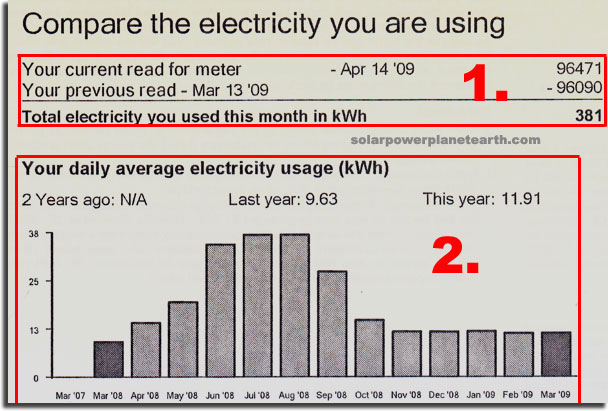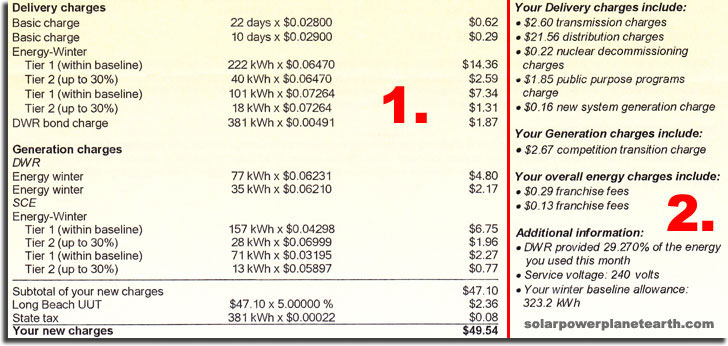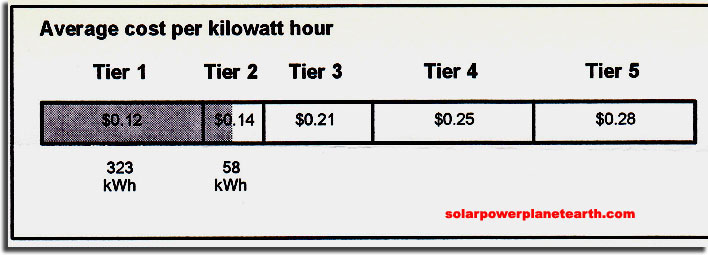How to Read Your Southern California Edison (SCE) Bill
In order to simplify the transition to solar power, you should first understand your electricity bill. Your bill will be slightly different once you energize your solar power system. This page will explain the standard Southern California Edison bill, which is your "pre-solar" bill. To better understand your SCE bill after you have a renewable energy system installed, see our page which explains the SCE Net-Metering agreement bill.
Southern California Edison Bill - Page 1
Page one of Southern California Edison's bill is shown and explained below.

(1) Total Electricity Used This Month in kWh
This section shows you the number of kilo-Watt-hours (kWh) you used this month. It shows the actual numbers read from your meter. It takes the numbers read this month, and subtracts the numbers read last month. You can think of the numbers on the meter as being analogous to your car mileage counter. For a better understanding of your electric meter, see our How to Read an Electric Meter page.
(2) Your Daily Average Electricity Usage (kWh)
This section has the most valuable information, as it shows how your electricity usage trends over the course of a year. Since your electricity use will typically vary from month to month as the seasons change (from air conditioning use, your refrigerator, etc...) it makes sense to compare the current months electricity use to that of the same month in prior years to truly give a trend of your conservation efforts. Edison compares these numbers in both the graph (example above shows March 07', March 08', and March 09'), and in text at the top of the graph (this year, last year, 2 years ago). *Note that March 07' is shown as zero and N/A in the example above due to this customer not having SCE service turned on until 2008.
Southern California Edison Bill - Page 2
Page two of Southern California Edison's bill is shown and explained below.

(1) Breakdown of All Your Charges
All of the different charges are broken down here. A lot of people wonder what all of these charges are, as they do look fairly confusing. The first of the two main sections, namely "Delivery Charges" has to do with the transmission of the electricity to your house. This includes the upkeep of transmission lines, transformers, sub stations, etc. The second section, "Generation Charges," has to do with the actual generation of electricity. There are many different methods of generation, from coal, nuclear, wind, solar, and geothermal.
Each of these sections breaks down costs for each Tier of electricity you fall into. The higher the tier, the more it costs per kWh. To not be confused by all these numbers, it should be understood that they all add up to the current advertised cost per kWh of electricity. In other words, if Edison says it charges twelve cents per kWh in tier one, then all of the charges associated with tier one, in both the delivery and generation sections, will add up to twelve cents per kWh.
(2) Further Explanations of Your Charges
The information in this section can be interesting in that it shows you where some of the charges come from. These charges are not in addition to what you see on the left, but where some of the money from those charges goes.
The TIER Bar
This bar is found on the bottom of the page shown above. As you already know, Edison charges you more per kWh, the more electricity you use. This method is used to encourage you to conserve power, so you are not charged the higher rates. The shaded part in the example above indicates how much power was used by this customer in that particular month. This customer used all 323kWh allocated for tier one, and 58kWh of tier two. This means that they were charged $0.12 per kWh for the first 323kWh, and $0.14 per kWh for the last 58kWh they used. Typically, with this type of structure, a solar power system would be sized to eliminate the top three most expensive tiers for maximum return on investment.

An Example of an Edison Bill Which Falls into Tier 5
The example below shows an edison customer who used enough electricity to reach tier five. The bill format is the same as the ones shown above. Notice the cost difference! Typically this type of bill is reached with the use of an air conditioning system during the summer.

Read about what your bill will look like after the installation of a solar power system.